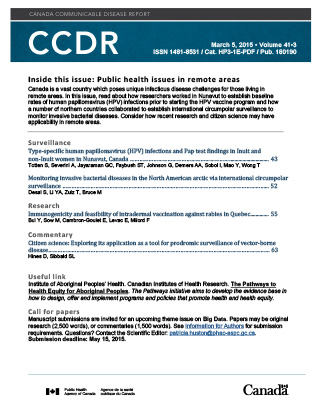CCDR: Volume 41-03, March 5, 2015: Public health issues in remote areas


Download the current issue as a PDF (1.07 MB - 26 pages)
Published by: The Public Health Agency of Canada
Date published: March 5, 2015
ISSN: 1481-8531
Submit a manuscript
About CCDR
Browse
In this issue: Public health issues in remote areas
Canada is a vast country which poses unique infectious disease challenges for those living in remote areas. In this issue, read about how researchers worked in Nunavut to establish baseline rates of human papillomavirus (HPV) infections prior to starting the HPV vaccine program and how a number of northern countries collaborated to establish international circumpolar surveillance to monitor invasive bacterial diseases. Consider how recent research and citizen science may have applicability in remote areas.
Table of contents
Surveillance
Type-specific human papillomavirus (HPV) infections and Pap test findings in Inuit and non-Inuit women in Nunavut, Canada
Totten S, Severini A, Jayaraman GC, Faybush ST, Johnson G, Demers AA, Sobol I, Mao Y, Wong T
Desai S, Li YA, Zulz T, Bruce M
Research
Immunogenicity and feasibility of intradermal vaccination against rabies in Quebec
Bui Y, Sow M, Cambron-Goulet E, Levac E, Milord F
Commentary
Citizen science: Exploring its application as a tool for prodromic surveillance of vector-borne disease
Hines D, Sibbald SL
Useful link
Institute of Aboriginal Peoples' Health. Canadian Institutes of Health Research. The Pathways to Health Equity for Aboriginal Peoples. The Pathways initiative aims to develop the evidence base in how to design, offer and implement programs and policies that promote health and health equity.
Call for papers
Manuscript submissions are invited for an upcoming theme issue on Big Data. Papers may be original research (2,500 words), or commentaries (1,500 words). See Information for Authors for submission requirements. Questions? Contact the Scientific Editor: patricia.huston@phac-aspc.gc.ca.
Submission deadline: May 15, 2015.
Search CCDR
Page details
- Date modified: